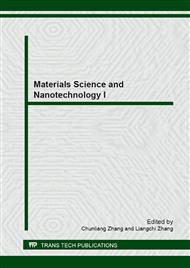p.186
p.190
p.196
p.200
p.204
p.208
p.212
p.216
p.220
Effects of pH Values on the Structure, Composition and Luminescence of CaWO4:Tb3+ Thin Films
Abstract:
It is hardly possible to obtain rare earth doped CaWO4 thin films directly through electrochemical techniques. A two-step method has been proposed to synthesize Tb3+-doped CaWO4 thin films. X-ray diffraction, energy dispersive X-ray analysis, spectrophotometer were used to characterize their phase, composition and luminescent properties. Results reveal that Tb3+-doped CaWO4 films have a tetragonal phase. The ratio of n(Tb)/[n(Ca)+n(Tb)+n(Na)] decreases with the increase of pH value of TbCl3 solutions. When the pH value (adjusted by NaOH) is higher than 5, Na element has been detected in CaWO4:Tb3+ thin films. Based on the analysis on the composition and luminescence, it can be concluded that the pH value of TbCl3 solutions must be no higher than 9.1, otherwise, no Tb3+-doped CaWO4 thin films can be obtained. Under the excitation of 237 nm, sharp emission peaks at 543 and 489 nm have been observed for Tb3+-doped CaWO4:Tb3+ thin films.
Info:
Periodical:
Pages:
204-207
Citation:
Online since:
December 2012
Authors:
Price:
Сopyright:
© 2013 Trans Tech Publications Ltd. All Rights Reserved
Share:
Citation:


